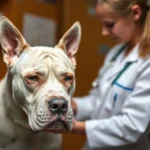
Introduction
Nutella is a beloved chocolate-hazelnut spread often found in pantries around the world. Its rich taste and versatility make it a popular choice for breakfast, snacks, and desserts. However, when it comes to our furry friends, sharing this indulgence can lead to serious health risks. My dog ate Nutella—this situation is one that many pet owners dread, and it’s essential to understand the implications of such an incident.
This article delves into the ingredients of Nutella, the associated risks for dogs, and the appropriate actions to take if your dog consumes this sweet treat. We’ll explore the symptoms of toxicity, when to seek veterinary care, and preventative measures to ensure your pet’s safety.
Understanding Nutella
What is Nutella?
Nutella is a popular spread made primarily from sugar, palm oil, hazelnuts, cocoa solids, and milk powder. Its creamy texture and sweet flavor make it a favorite among people of all ages. Often used on toast, pancakes, and in desserts, Nutella is a go-to item for many households.
Key Ingredients of Nutella
The primary ingredients in Nutella include:
- Sugar: A sweetener that can lead to obesity and dental issues in dogs.
- Palm Oil: A fat that may not be toxic but can cause digestive upset.
- Hazelnuts: Generally not toxic; however, they can pose choking risks or cause gastrointestinal distress.
- Cocoa Solids: Contains theobromine, which is toxic to dogs.
- Milk Powder: Can cause digestive issues, especially in lactose-intolerant dogs.
- Lecithin: An emulsifier that is generally safe for dogs.
- Vanillin: A flavoring agent that is typically non-toxic.
Among these ingredients, chocolate (specifically the cocoa solids) poses the greatest risk to dogs, making it crucial for pet owners to be vigilant about what their pets consume.
The Risks of Dogs Eating Nutella
Chocolate Toxicity in Dogs
Chocolate toxicity is one of the most serious concerns when it comes to dogs eating Nutella. The key component in chocolate that is harmful to dogs is theobromine, which dogs metabolize much more slowly than humans. The presence of caffeine in chocolate compounds the issue. Symptoms of chocolate toxicity can manifest within hours of ingestion and can vary based on the type and amount of chocolate consumed.
Other Harmful Ingredients
In addition to the dangers posed by chocolate, other ingredients in Nutella can be harmful:
- Sugar: Excessive sugar intake can lead to obesity, dental problems, and even diabetes in dogs.
- Palm Oil: While not toxic, it can cause gastrointestinal upset and contribute to obesity.
- Dairy Products: Many dogs are lactose intolerant, leading to digestive issues such as diarrhea or vomiting.
Understanding these risks is essential for any dog owner who might be tempted to share their favorite treat with their furry companion.
Symptoms of Nutella Ingestion
If your dog consumes Nutella, symptoms may vary based on the amount ingested and your dog’s size. Common symptoms to watch for include:
- Vomiting
- Diarrhea
- Restlessness
- Increased heart rate
- Seizures
It’s vital to monitor your dog closely for any signs of discomfort or distress, as early intervention can be critical.
Immediate Actions for Dog Owners
Assessing the Situation
When faced with the concern of my dog ate Nutella, the first step is to assess the situation. Consider the following:
- Size of the dog: Smaller dogs are more susceptible to the effects of toxic substances.
- Amount consumed: A small lick may not be harmful, but larger quantities can be dangerous.
- Time of ingestion: If your dog consumed Nutella recently, you may have more options for intervention.
Remaining calm is crucial—panicking will not help your dog and may cloud your judgment regarding the next steps.
Home Remedies and Care
If you believe your dog has consumed a small amount of Nutella, there are a few things you can do at home:
- Inducing vomiting: Only do this if advised by a veterinarian. It’s important to contact your vet first, as inducing vomiting can sometimes cause more harm than good.
- Monitoring food and water intake: Ensure your dog stays hydrated and monitor for any changes in their eating habits.
However, it’s essential to know when home remedies are appropriate versus when to seek professional help. If your dog shows any signs of distress or if you are unsure about the severity of the situation, err on the side of caution and contact your veterinarian.
When to Contact a Veterinarian
Signs That Require Immediate Veterinary Attention
There are critical symptoms that indicate your dog requires urgent veterinary care after consuming Nutella:
- Persistent vomiting or diarrhea
- Severe restlessness or agitation
- Rapid or irregular heartbeat
- Seizures or tremors
- Lethargy or weakness
If you notice any of these symptoms, do not wait—contact your veterinarian immediately. The sooner you act, the better the chances are for a positive outcome.
What to Expect at the Vet
If you take your dog to the vet for Nutella ingestion, here’s what you can expect:
- Induced vomiting: If the ingestion was recent, the vet may induce vomiting to prevent further absorption of toxins.
- Activated charcoal: This can be administered to limit the absorption of theobromine in the digestive system.
- IV fluids: If your dog is dehydrated or requires additional support, IV fluids may be given.
- Veterinary tests: Blood tests may be performed to assess the level of theobromine and other factors.
Your veterinarian will evaluate the situation based on your dog’s size, the amount of Nutella consumed, and the symptoms presented.
Preventative Measures
Training and Behavior Adjustments
To prevent future incidents involving Nutella or other human foods, consider the following training tips:
- Teach commands: Commands like “leave it” or “no” can help deter your dog from approaching food that isn’t theirs.
- Positive reinforcement: Reward your dog for ignoring food or staying away from the counter.
- Safe environments: Make your kitchen a safe zone by keeping food out of reach and securing trash cans.
Educating Family and Friends
It’s essential to communicate the dangers of sharing human food with pets, especially with family and friends who may not realize the risks. Discussing these issues openly can help prevent accidents. Consider creating a list of dog-safe treats to share with others, ensuring everyone understands what’s safe for your pet.
Conclusion
Understanding the risks of my dog ate Nutella is crucial for every dog owner. Nutella contains ingredients that can be harmful to dogs, particularly chocolate, which can lead to serious health issues. By being proactive, assessing situations calmly, and knowing when to seek veterinary care, you can ensure your dog’s safety and well-being.
Always prioritize your pet’s health by educating yourself about food safety and being vigilant about what they consume. Remember that your dog’s health and happiness depend on the choices you make as a responsible pet owner.
FAQs
Can a small amount of Nutella harm my dog?
While a small lick may not cause immediate harm, it’s essential to remember that even small amounts of chocolate can pose risks, especially for smaller dogs. It’s best to err on the side of caution and monitor your dog closely.
What if my dog has a reaction after eating Nutella?
If your dog shows any adverse reactions after consuming Nutella, such as vomiting, diarrhea, or lethargy, contact your veterinarian immediately. Monitoring their symptoms is crucial for their health.
Are there dog-safe alternatives to Nutella?
Yes, there are dog-safe treat options available, such as peanut butter (without xylitol), pumpkin puree, or specially formulated dog treats. Always check the ingredient list to ensure safety for your furry friend.









